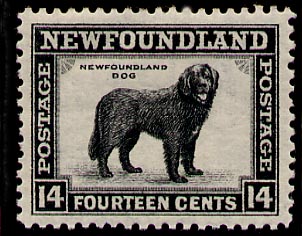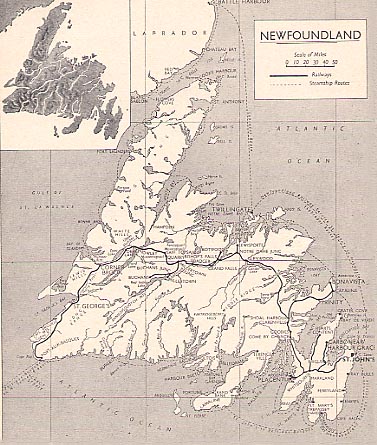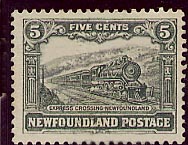
History

 |
Newfoundland History |
 |
Newfoundland Railways
(to 1949)
[This text was written in 1949. For the full citation, see the end of the document. Images and links have been added to the original text by Claude Bélanger. Further information is also provided at this site.]
Construction of the first railroad in Newfoundland began in 1881, when the Newfoundland Railway Company undertook to build a narrow gauge line from St. John's to Harbour Grace. There was considerable opposition to the railway, and in the summer of 1881 several hundred inhabitants of the south shore of Conception bay, persuaded by agitators that their possessions were being taken away from them, armed themselves, and in a riot which has become known as the "battle of Foxtrap", put a temporary stop to construction of the line. After completing some 60 miles of track, the company defaulted, and the line reverted to English shareholders who completed the line to Harbour Grace. Daily service, six days a week, from St. John's to Salmon Cove, was begun in 1884.
The Whiteway administration, which had inaugurated the railway policy, was replaced in 1885 by the Thorburn government, which built and in 1888 opened a railway from Whitbourne to Placentia . Construction was managed by the government, and had been carried forward to Rantem in 1889 when it was decided by Sir William Whiteway, who had returned to the premiership to have the line completed by a contractor.

Map of the railway and ferry lines of Newfoundland
in the early 1950's
The contract was awarded to Robert Reid in 1890, and the road had been completed, through Norris Arm to Port aux Basques, by 1897. Under an agreement signed in 1893, Mr. Reid undertook, for a grant of 5,000 acres for each mile of track, to operate the railroad for ten years; and the first train to cross the island left St. John's on June 29, 1898.
By another contract, the "Reid deal" concluded by the ministry of Sir James Winter in 1898, the Reid Newfoundland Company was given further grants of land and gained control not only of the railway but also of the St. John's dry dock, the telegraph lines, and the coastal mail and passenger service.
This Reid contract was modified by a new agreement with the government of Sir Robert Bond in 1901, but the company continued to operate the railway and steamship services. In 1910 the company contracted with the government of Sir Edward Morris to build six branch lines, and four of the lines were in operation by 1915. In 1920 the Reid Newfoundland Company, then operating at an annual loss of about $1,500,000, appealed to the government for financial aid. In 1921, operation of the railway and steamship services was taken aver temporarily by a government commission, and Sir George Burry, a former vice-president of the Canadian Pacific Railway, was called in to make recommendations. Acting upon his advice, the government appointed a general manager of the railway to act under the supervision of the Reid Newfoundland Company, but the arrangement led to a deadlock and finally, on July 1, 1923, for a consideration of $2,000,000, the company and its subsidiary companies retired absolutely from all transportation operations in Newfoundland.

"The Newfie Bullitt" as it was affectionnately called by Newfoundlanders.
The train would virtually stop anywhere along the line to collect or leave passengers.
The government improved the main line, and built a new dock. The 1930's saw several of the branch lines abandoned. The construction of large military bases on the island during World War II brought about heavy increases in freight and passenger traffic, so that the railroad's revenue tripled and, for almost the first time, met the cost of operation.
The Newfoundland Railway and Steamship Services in 1949 became known as Canadian National Railways, Newfoundland Services.
Source: W. Stewart WALLACE, ed., The Encyclopedia of Canada. Newfoundland Supplement, Toronto, University Associates of Canada, 1949, 104p., pp. 87-90.
© 2004 Claude Bélanger, Marianopolis College |